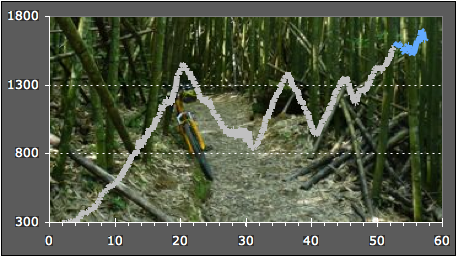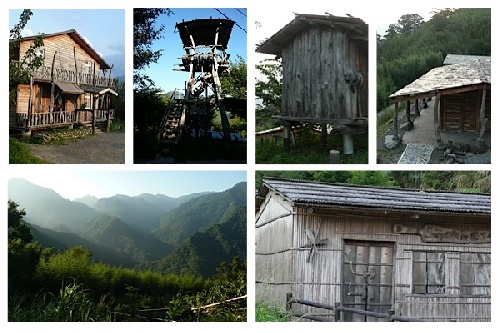-
斯馬庫斯跟神木步道, Smangus and the sacred trees
 A bicycle trip to Smangus 斯馬庫斯 is undoubtedly a both physical and spiritual adventure, welcome to the village of gods ! Two days trip.
A bicycle trip to Smangus 斯馬庫斯 is undoubtedly a both physical and spiritual adventure, welcome to the village of gods ! Two days trip.
到斯馬庫斯騎腳踏車無疑是一種心理的挑戰和精神之旅,歡迎光臨上帝的部落!


Global route 全路資料 
Elevation gain 高差: 2550m
Distance 距離: 2x58km
Offroad 越野: 10km
Loop 循環: NoOff-road details 越野細節 
Grade 級: 2 - Easy
Track quality 質量: Excellent
Push/Carry 推攜帶: No
Commitment 危險: LowElevation graph 放大圖 Watch more pictures 觀賞更多照片 Watch the map 看地圖
I heard that the village of Smangus 斯馬庫斯 [Simakusi] is the remotest aboriginal village in Taiwan, the last place which was electrified (in 1979), and that it is only connected to the rest of the world by an awesome 16km 4WD track. This was enough appeal to stimulate a trip to this area, and check whether all these assertions are true ! But for sure I didn't expect so many good surprises.
Although Smangus lies close to the geographic middle line of Taiwan, it is however relatively easy of access. Indeed, there is a secondary train line from Hsinchu city leading to the east. It terminates in the small city of 內灣 [Neiwan], which is only 53km from Smangus 斯馬庫斯 [Simakusi]. Well, there is still an issue : the train line is on maintenance at the moment... But because I couldn't wait until the train is fixed, I decided to drive there and parked my car at 尖石 [Jianshi] on a little free parking before the bridge. All the way from 內灣 is charming and follows large rivers in a peaceful environment. The whole place is populated by aboriginals of the Atayal 泰雅 group and the road crosses many villages with lovely churches.
In 竹圍 [Zhuwei], a second bridge needs to be crossed, leading to a steep cliff road and several great rock formations lie along the river, they are worth having a break. The subsequent climb up to the saddle offers a fresh atmosphere and plenty of scenic views over the valley and the surrounding summits, which look lower and lower as the road progresses. Arriving at the saddle is both a great relief and a great viewpoint. Nothing is flat behind there, it's all steep up and steep down. Tiny villages hang on the mountains above invisible abysses, but Smangus 斯馬庫斯 is not yet in the scope. I just started to understand why this village is so remote. The main rivers of this area come from the butresses of the Snow Mountain 雪山 (3886m). They all dig gorges into the rocks, so that the aboriginals could not establish along them, but only several hundred meters above. The road follows the villages along the vagaries of field, constantly up and down. And because two main rivers have to be crossed before reaching Smangus 斯馬庫斯, then the steep road needs to be ridden twice all the way down, then all the way up.

The road down to 秀巒 [Xiuluan] checkpoint is highly scenic, and I had ample time to reflect about the geological origins of such a tough world and to draw comparisons with my home mountains. On the way up to the peach fields of 泰崗 [Taigang] under a merciless late morning sun, I clarified the idea why Smangus 斯馬庫斯 is called "the village of God". This must be because the way to this place is long, such as the way to God is a long way... also because I might need the help of God to reach my destination! I was probably influenced by the landscapes, which become wilder and wilder as the road goes on.

But on the way down to Simakusi bridge 斯馬庫斯橋, I was surprised and disapointed that the so-called 4WD track is actually nothing but a clean paved road, except a few places damaged by typhoons. However, some very steep sections are really exhausting, every kilometer is a victory and the temptation to push the bike very high ! The scenery from the road covers the inhabited areas of 雪山, with some breathtaking views on the rivers. Contrary to the low forests of Taiwan, the ground here is dry and the forest exhales marvellous conifer scents reminding me of the Provence hills.


Arriving Smangus 斯馬庫斯 is an unforgettable moment. I certainly looked seriously exhausted, because local habitants came to my rescue and helped me to find food for lunch and a comfortable place to stay overnight. Taiwanese people are very friendly in general, but in Smangus 斯馬庫斯 I met the friendliest ever. Moreover they craft their own houses on a very beautiful way, using a lot of wooden elements. There are both traditionnal and modern houses, a church, a new classroom, wooden sculptures and a nice central square, the village is really lovely.

A guided tour at 4:30 (in chinese only) introduces to the places of interest, but also to the singularity of Smangus 斯馬庫斯. Because this village is managed by its own community principles that all villagers work together, receive the same salary and share the collective tasks and duties. Quite opposite to the mainstream Taiwanese way. And my biggest surprise was to learn that a few kilometers further, a millenium tree forest was preserved.

After a tasty dinner in the community restaurant and an excellent night, I decided to visit this mysterious forest. Actually, this is definitely the best part of the trip and it would be a pity to ride to Smangus 斯馬庫斯 without continuing 5km on the trail. As the french say "this is the cherry on the cake". It is a trail like no other in Taiwan, very well maintained with small wood and bamboo bridges on the collapsed parts, but without fancy suspended bridges or stone steps. It can be ridden all the way and the surface is excellent. But watch out that on week-ends there can be a lot of hikers.

The ride crosses gorgeous places, such as thick bamboo forests, steep landslides and eventually the hinoki cypress forest. The hinoki forest exhales a special scent of resin that is as penetrating as incense, thus the expression "sacred trees forest" is very well chosen. This was my first time in Taiwan to visit giant trees, and I reckon they are just stunning. The place has an intemporal mystic beauty and each tree is more amazing than the other one. One of them is more than 3000 years old.

After such glorious emotions, going back home was not granted yet. The inbound trip is twice easier than the outbound, however the main climbs faces east, thus exposed to the morning sun. But I had been so delighted by this visit to Smangus 斯馬庫斯 that I didn't feel the fatigue.
Additional information:
Date: August 27-28th, 2009
Temperature: 28 Celsius in 尖石 [Jianshi]
Participants: Alexis
Access: No train to Neiwan at the moment.
Condition of the paved road: Good except about 500m distance.
Drinkable water: Villages, then natural rivers.
Permit: Yes. Apply directly at 秀巒 [Xiuluan] checkpoint.
Itinerary :
From Neiwan station 內灣站, follow road 120縣道 to 尖石 [Jianshi] (3.3km).
Turn right on the bridge to road 竹60鄉道 to 竹圍 [Zhuwei].
Turn left on 竹圍 bridge, following the same road 竹60鄉道.
Climb to the saddle, and at km 20, don't follow the 斯馬庫斯 sign to the left, but turn right and reach directly 上宇老, [Shangyulao] at 1450m. The left road leads to a higher saddle (1490m).
Go all the way down and follow the 斯馬庫斯 signs until the end... Tags: smangus, clean trail, grade 2, sacred trees, hinoki, bamboo, simakusi, no stairs
Tags: smangus, clean trail, grade 2, sacred trees, hinoki, bamboo, simakusi, no stairs
-
Comments
2yijuSaturday 24th October 2009 at 01:15謝謝你發現台灣的美 Suivre le flux RSS des commentaires
Suivre le flux RSS des commentaires
 Add comment
Add comment
和平與騎 Take a ride on the wild side


You find so many beautiful spots that we have never been before. I will pass your website to people who like hiking and cycling. Thank you for loving this place in different way. Ulica xx